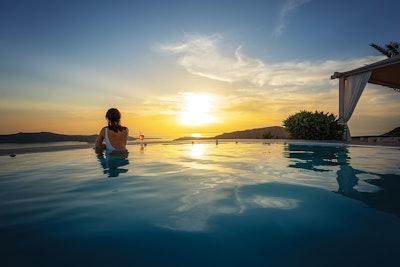
The transformation of U.S. energy infrastructure and policy has been underway for decades, driven by two imperatives: conservation and fossil-fuel reduction.
The impact on our industry has been profound, exemplified by the long push for variable-speed pumps, which culminated in the DOE pump regulations that outlawed the manufacture of most single-speed pool pumps on the market in 2021.
It’s important to remember that the VSP movement, at least on a policy level, really began with California’s Title 20 regulations in 2008, gained horsepower and rpm over time, swept over the country and eventually became a national mandate.
The DOE pump regulations remain the industry’s single greatest conservation success to date. The other main energy initiative of the 21st century, migration from fossil fuels to renewables, is just getting started.
The idea is to replace combustion fuel power with electricity, which (hopefully) can eventually be generated in sufficient quantities through cleaner technologies such as solar, wind, geothermal, etc.
Which brings us to this story on gas heaters, the only component of a pool system that directly consumes fuel.
The policy fight to reduce/eliminate gas pool heat is once again being led by California and its Air Resources Board (CARB).
In September of 2019, Berkeley, acting alone as a municipality, became the first U.S. city to ban the installation of natural gas lines in all new construction. Other cities in the state followed suit, including San Jose, Oakland, Santa Rosa and Santa Monica, and in time, more than 50 cities and towns in California adopted regulations that ban or discourage the use of natural gas. In May of 2022, the state’s largest city, Los Angeles, joined ranks by banning natural gas burners in new construction.
In September, CARB weighed in at the state level by unanimously approving a comprehensive plan to reduce emissions from multiple sources by 2030. While no specific actions are dictated by this plan, it directs state agencies to draft a rule to phase out many products that use combustible fuels, including “water heaters” by 2025.
Packaged with the plan was a statement from CARB Chair Liane Randolph calling on the federal government to pick up the ball and run with it as it has in the past. The CARB document does not specifically call out “gas pool heaters” by name, and it’s true that the details of the final rule will determine the impact of the industry. Those details will be the product of negotiation.
Dan Sizelove, vice president of sales and marketing at Solar Industries, emailed CARB asking for clarity, and received the following reply:
CARB will be kicking off a formal rulemaking process in early 2023 to develop the zero-emission standard for space and water heating. Whether or not the zero-emission standards would apply to pool heating is something that CARB staff will explore during the rulemaking process.
CARB staff are currently identifying all the key stakeholders that would be affected by the regulation. Staff will meet with these stakeholders to gather ideas and concerns. Stakeholders will also have an opportunity to participate in the public process. The regulation is scheduled to be taken to the Board for consideration no later than 2025 with implementation beginning in 2030.
So, important specifics remain to be determined. If the ban is eventually enacted into law, and if it does include gas pool heaters, it will be a significant blow to the pool industry in California in terms of direct sales, and very possibly in terms of customer satisfaction with pools.
“It has long been standard practice for California builders to drop in a 400k Btu/hr gas heater on a pool/ spa combo; rarely is the heater used to heat the pool, though it’s still sized to allow for a relatively quick heat-up when desired (think pool party early/late in the season). Rather, gas is predominantly used to heat the spa,” Sizelove says.
“There are many homeowners in the northern part of the state for which gas is the only viable option for heating in the spring and fall (the “shoulder points” of the season, as we call them). To strip their ability to do so will undoubtedly lead some to a self-fulfilling prophecy for the pool industry…‘I can’t heat it, so I use it less… and because I use it less, filling it in seems like a better and better idea every day.’ It will lead to fewer pools and spas being built.”
This article first appeared in the January 2023 issue of AQUA Magazine — the top resource for retailers, builders and service pros in the pool and spa industry. Subscriptions to the print magazine are free to all industry professionals. Click here to subscribe.












































